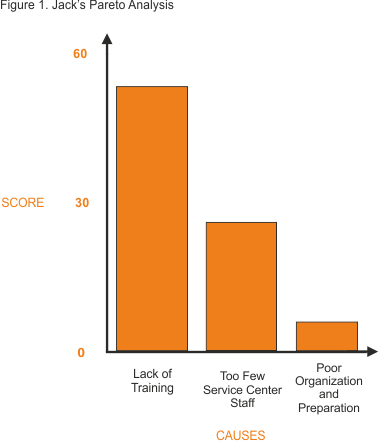A previously we had to know the definition and types of decision making ( decision-making ) , so this time we will discuss about what are the techniques of decision making ( decision making) . In the book Mind Tools : Essential Skills for an Excellent Career by James Manktelow in 2003 , here are seven kinds of decision-making techniques Manktelow , 2003:
A technique used for decision making based on the Pareto Principle, known as the 80/20 rule. It is a decision-making technique that statistically separates a limited number of input factors as having the greatest impact on an outcome, either desirable or undesirable. Pareto analysis is based on the idea that 80% of a project's benefit can be achieved by doing 20% of the work or conversely 80% of problems are traced to 20% of the causes.
Pareto Analysis is a fairly simple technique because this technique helps us to solve an important problem to be solved first. This technique uses the Pareto principle that the main idea is to do the work and produce 20 % to 80 % profit from all the work . The steps in conducting engineering Pareto Analysis : Make a list of problems that are being faced or the options available. If you have a lot of problems , grouped according the size. Give the exact scores for each group. Complete the groups that have the highest scores .

Ideally, you want to focus your attention on fixing the most important problems. But how do you decide which problems you need to deal with first? And are some problems caused by the same underlying issue?
Pareto Analysis is a simple technique for prioritizing possible changes by identifying the problems that will be resolved by making these changes. By using this approach, you can prioritize the individual changes that will most improve the situation.
Pareto Analysis uses the Pareto Principle – also known as the "80/20 Rule" – which was developed by Joseph M. Juran in 1937. It is the idea that 20 percent of causes generate 80 percent of results. With this tool, we're trying to find the 20 percent of work that will generate 80 percent of the results that doing all of the work would deliver.
Note:
The figures 80 and 20 are illustrative – the Pareto Principle illustrates the lack of symmetry that often appears between work put in and results achieved. For example, 13 percent of work could generate 87 percent of returns. Or 70 percent of problems could be resolved by dealing with 30 percent of the causes.How to Use the Tool
Step 1: Identify and List Problems
Firstly, write a list of all of the problems that you need to resolve. Where possible, talk to clients and team members to get their input, and draw on surveys, helpdesk logs and suchlike, where these are available.Step 2: Identify the Root Cause of Each Problem
For each problem, identify its fundamental cause. (Techniques such as Brainstorming , the 5 Whys , Cause and Effect Analysis , and Root Cause Analysis will help with this.)Step 3: Score Problems
Now you need to score each problem. The scoring method you use depends on the sort of problem you're trying to solve.For example, if you're trying to improve profits, you might score problems on the basis of how much they are costing you. Alternatively, if you're trying to improve customer satisfaction, you might score them on the basis of the number of complaints eliminated by solving the problem.
Step 4: Group Problems Together By Root Cause
Next, group problems together by cause. For example, if three of your problems are caused by lack of staff, put these in the same group.Step 5: Add up the Scores for Each Group
You can now add up the scores for each cause group. The group with the top score is your highest priority, and the group with the lowest score is your lowest priority.Step 6: Take Action
Now you need to deal with the causes of your problems, dealing with your top-priority problem, or group of problems, first.Keep in mind that low scoring problems may not even be worth bothering with - solving these problems may cost you more than the solutions are worth.
Note:
While this approach is great for identifying the most important root cause to deal with, it doesn't take into account the cost of doing so. Where costs are significant, you'll need to use techniques such as Cost/Benefit Analysis , and use IRRs and NPVs to determine which changes you should implement.Pareto Analysis Example
Jack has taken over a failing service center, with a host of problems that need resolving. His objective is to increase overall customer satisfaction.He decides to score each problem by the number of complaints that the center has received for each one. (In the table below, the second column shows the problems he has listed in step 1 above, the third column shows the underlying causes identified in step 2, and the fourth column shows the number of complaints about each column identified in step 3.)
| # | Problem (Step 1) | Cause (Step 2) | Score (Step 3) |
|---|---|---|---|
| 1 | Phones aren't answered quickly enough. | Too few service center staff. | 15 |
| 2 | Staff seem distracted and under pressure. | Too few service center staff. | 6 |
| 3 | Engineers don't appear to be well organized. They need second visits to bring extra parts. | Poor organization and preparation. | 4 |
| 4 | Engineers don't know what time they'll arrive. This means that customers may have to be in all day for an engineer to visit. | Poor organization and preparation. | 2 |
| 5 | Service center staff don't always seem to know what they're doing. | Lack of training. | 30 |
| 6 | When engineers visit, the customer finds that the problem could have been solved over the phone. | Lack of training. | 21 |
- Lack of training (items 5 and 6) – 51 complaints.
- Too few service center staff (items 1 and 42) – 21 complaints.
- Poor organization and preparation (items 3 and 4) – 6 complaints.

By carrying out a Pareto Analysis, Jack is able to focus on training as an issue, rather than spreading his effort over training, taking on new staff members, and possibly installing a new computer system to help engineers be more prepared.
Key Points
Pareto Analysis is a simple technique for prioritizing problem-solving work so that the first piece of work you do resolved the greatest number of problems. It's based on the Pareto Principle (also known as the 80/20 Rule) – the idea that 80 percent of problems may be caused by as few as 20 percent of causes.To use Pareto Analysis, identify and list problems and their causes. Then score each problem and group them together by their cause. Then add up the score for each group. Finally, work on finding a solution to the cause of the problems in group with the highest score.
Pareto Analysis not only shows you the most important problem to solve, it also gives you a score showing how severe the problem is.

Tidak ada komentar:
Posting Komentar